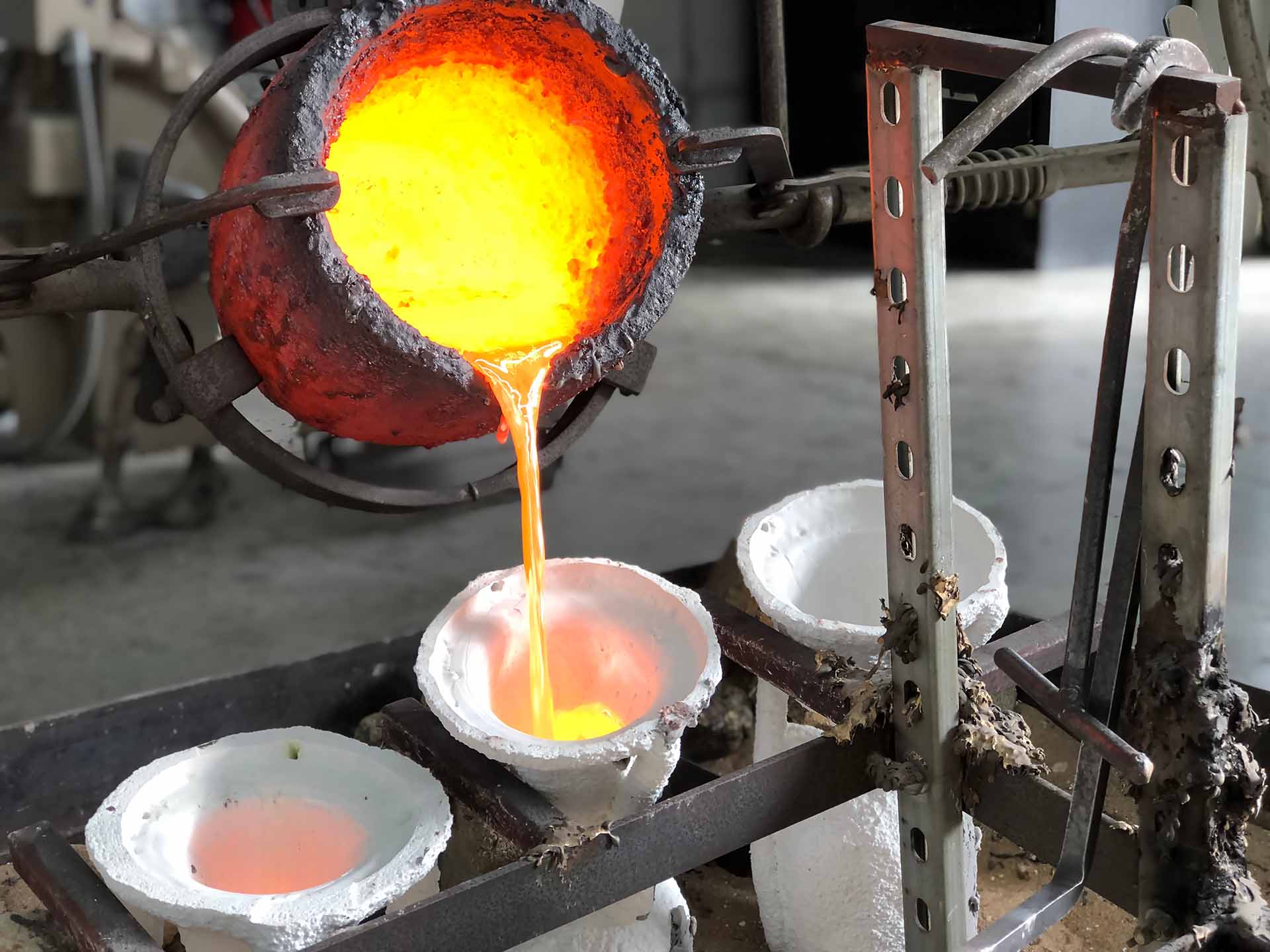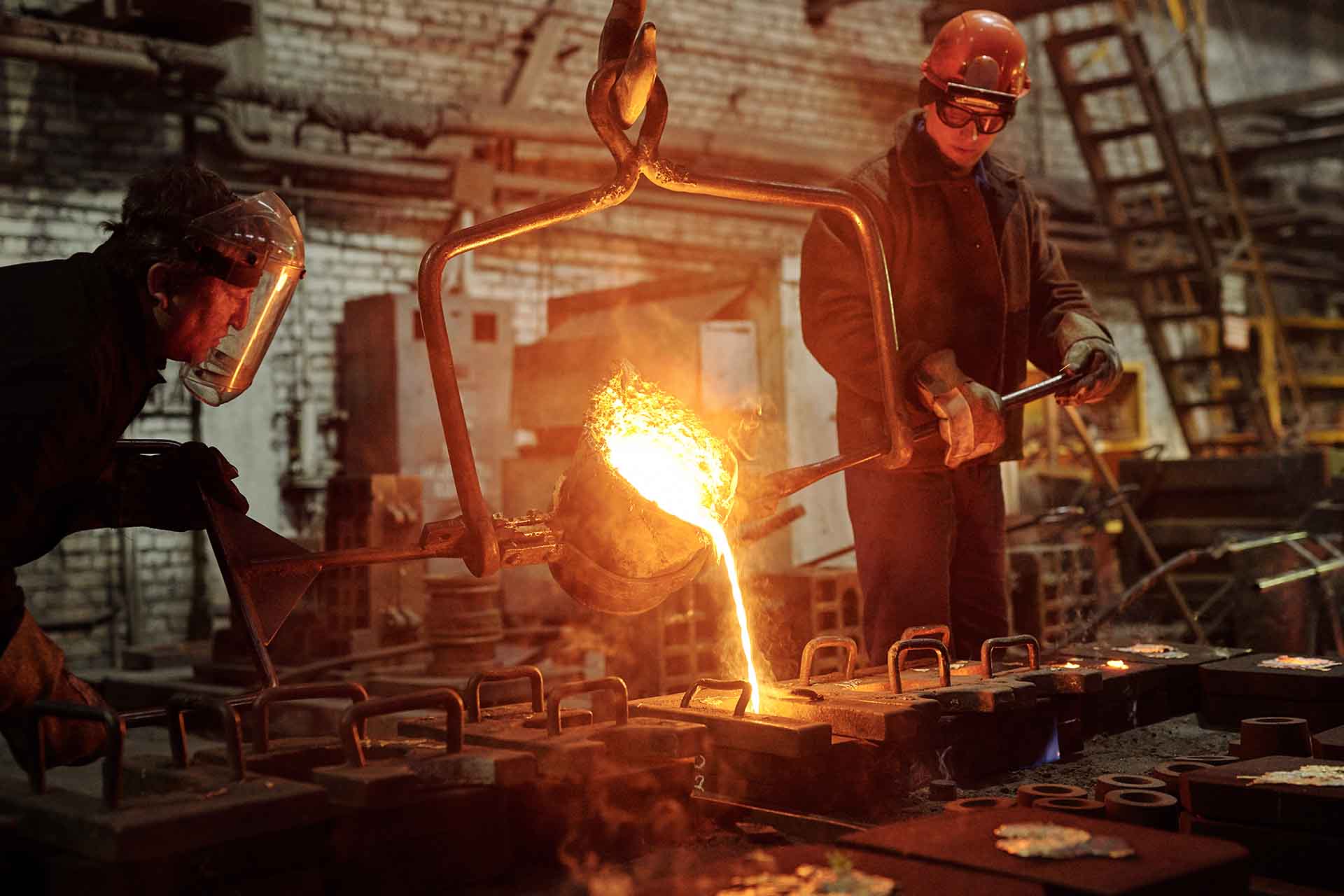Sand Mold Patterns &
Sand Casting Foundry Services
At Alabama Copper and Bronze, we take immense pride in housing state-of-the-art molding machines that are the backbone of our sand casting operations.
Engineered for precision and reliability, our machines ensure uniform sand compaction around the pattern, which is critical for achieving high-quality castings. Capable of handling various sand types and mold complexities, these machines are equipped with advanced sensors and control systems for real-time monitoring and adjustments. This allows us to optimize each molding cycle, reducing waste and improving efficiency. Whether it’s a simple, single-cavity mold or a complex, multi-core setup, our molding machines offer the flexibility and precision required to meet diverse casting needs. By investing in cutting-edge technology, we not only uphold the highest quality standards but also offer our clients cost-effective solutions for their casting requirements.
Sand Casting Foundry Process
Sand molding is a time-tested method for forming molten metal into specific shapes. Using a mixture of sand and binding agents, we create sand casting molds that can withstand the high temperatures of molten metal, allowing us to produce high-quality castings in a variety of shapes and sizes. Whether you are an engineer, a potential customer, or simply someone curious about foundry processes, this guide aims to provide you with all the information you need to understand sand molding.
Why Choose Sand Molding
Sand molding holds a distinct advantage over other types of molding processes for several reasons.
- 1
Cost-Effectiveness: Sand is a readily available and inexpensive resource, making this method cost-effective, especially for low to medium-volume production runs.
- 2
Versatility: The flexibility of the sand mold process allows for the production of complex geometries and intricate designs that might be challenging for other methods.
- 3
Scalability: Whether you are looking to create a single prototype or mass-produce thousands of pieces, sand molding can be easily scaled to meet different production needs.
- 4
Quality: With proper quality control measures, sand molding can yield high-quality castings that meet industry standards.
- 5
Reusability: The sand used in the molding process can often be reclaimed and reused, contributing to the sustainability of the process.
- 6
Customization: Due to its adaptability, sand molding is ideal for bespoke or customized solutions, offering the flexibility to adapt the mold to the specific requirements of the project.
Sand molding is a versatile, cost-effective, and reliable method for metal casting, offering a range of advantages that make it a preferred choice for many applications.
Types of Sand Molds
When it comes to sand molding, one size certainly doesn’t fit all, and the type of sand mold used can greatly influence the quality, cost, and feasibility of producing a particular casting. The most commonly used types are green sand molds, no bake molds, and shell molds.
Green sand molds
Green sand molds are the most cost-effective and are made from a mixture of sand, clay, and water, which gives the sand its ‘green’ or uncured characteristics. They are particularly well-suited for simpler, high-volume castings but can lack the precision and surface finish provided by other types of molds.
No-bake molds
No-bake molds, on the other hand, use a chemical binder to bond the sand grains together. They offer superior dimensional accuracy and are ideal for larger and more complex components but can be more costly.
Shell molds
Shell molds are made by coating a layer of sand mixed with a thermosetting resin onto a heated pattern. This produces molds with excellent dimensional accuracy and surface finish but typically comes with higher material and production costs. Each type has its pros and cons, and the choice of sand mold often depends on factors like the complexity of the design, the type of metal being used, and the production volume.
Pattern Making
Pattern making is the critical first step in the sand molding process and serves as the blueprint for your final casting. The pattern is a physical model designed to mirror the shape and intricacies of the object you aim to cast. Typically crafted from materials such as wood, plastic, or metal, the pattern is designed with precision, taking into account factors like shrinkage of the metal as it cools and allowances for machining. The pattern is not just a replica of the desired final object; but also includes other elements such as gates and risers, which facilitate the flow of molten metal into the mold and allow for the escape of gases. Additionally, if the final casting consists of internal cavities or complex geometries, separate core boxes may be created alongside the pattern. The accuracy and quality of the pattern directly impact the quality of the final casting, making this stage a blend of engineering skill, material science, and artisan craftsmanship. Pattern making is performed by our professional staff who utilize both traditional techniques and modern technologies, such as computer-aided design (CAD) and 3D printing, to achieve the highest level of precision and detail.
Sand Mold Preparation
Casting mold preparation is a multifaceted stage that sets the stage for the entire casting process. It begins with the careful mixing of molding sand, binders, and any other requisite additives to create the molding material with the desired properties, such as strength and permeability. This mixture is then placed around the pattern within a molding box, often referred to as a “flask,” which comes in two halves: the cope (top) and the drag (bottom).
The sand mixture is compacted to ensure it tightly conforms to the pattern’s contours. During this stage, special attention is paid to ensure uniform density throughout the mold to avoid defects like porosity or incomplete filling. If the casting design requires internal features, cores made of sand or other materials are prepared separately and positioned within the mold cavity.
Finally, the two halves of the mold are assembled, often with alignment pins to ensure correct positioning. Vent holes may also be added to facilitate the escape of gases during the pouring of molten metal, preventing defects like gas porosity. The preparation of the mold is a balance of science and art, requiring a deep understanding of materials, thermodynamics, and design considerations. Failure at this stage could result in costly casting defects, making mold preparation a critical focus for achieving high-quality results.
Pouring Process
The pouring stage is where the transformation from liquid metal to a solid form begins, and it requires a meticulous approach to ensure the integrity of the final casting. Prior to pouring, the mold may be preheated or coated with a refractory material to enhance flow and minimize defects. The metal, having been melted in our furnace to a specific temperature, is carefully transferred to the mold using ladles. The speed and temperature of the pour are meticulously controlled to minimize turbulence, which can introduce air or gas pockets into the casting, leading to defects.
The molten metal must fully fill the mold cavity, including intricate features and recesses, which is why the design of gating systems (channels for directing the flow of metal) is a key aspect of pattern making. Equally important is the timing; too fast a pour can lead to splattering and incomplete filling, while too slow a pour can result in premature solidification before the mold is filled. The process often involves monitoring and adjustments in real-time, relying on both technology and the expertise of our foundry artisans. Given that the metal’s behavior during pouring can impact factors like dimensional accuracy, surface finish, and mechanical properties, this stage is critical for achieving a high-quality casting and is considered an art as much as it is a science.
Sustainability
In Our Sand Molding Process
Sustainability is not just a buzzword at Alabama Copper & Bronze; it’s a core value deeply integrated into our operations. One of the standout features of our foundry is our commitment to recycling sand molds, a practice that significantly reduces waste and environmental impact. After each casting process, the sand from broken molds is carefully collected, cleaned, and treated to remove any impurities or residual metal. It then undergoes rigorous quality tests before being reintroduced into the molding cycle. This closed-loop recycling system not only minimizes our consumption of raw materials but also lessens our carbon footprint, making the entire casting process more eco-friendly. By prioritizing sustainability, we offer our clients a responsible choice without compromising on the quality and integrity of our castings.
Turn Your Vision into Reality
At Alabama Copper & Bronze, we combine decades of expertise with cutting-edge technology to deliver unparalleled quality in sand casting. From intricate designs to large-scale components, our team is committed to turning your ideas into tangible, high-performing products. But we don’t just stop at manufacturing; we’re also committed to sustainability, ensuring our processes are as eco-friendly as possible.
Contact us today to discuss your project needs, and let’s create something extraordinary together.
Sand Mold FAQ
Sand molding is versatile and can be used to cast a wide range of ferrous and non-ferrous metals, including but not limited to iron, steel, aluminum, bronze, and copper.
The accuracy of sand-cast parts can vary depending on several factors, such as the type of sand used, the quality of the pattern, and the casting process itself. However, advancements in technology have significantly improved the dimensional accuracy and surface finish achievable through sand casting.
Sand molding is widely used across a diverse range of industries including automotive, aerospace, machinery, construction, oil & gas, and maritime sectors. Its flexibility in accommodating various metals and complexities makes it a go-to option for manufacturing parts that vary from engine components to housing structures.
Lead times can vary depending on the complexity of the part, the type of metal being used, and the foundry’s schedule. However, sand casting generally offers shorter lead times compared to other casting methods, particularly for low-to-medium volume production.
Many foundries, including Alabama Copper & Bronze, have adopted sustainable practices like sand recycling to make the sand molding process more eco-friendly.
While sand molding is versatile and cost-effective, it may not be suitable for extremely intricate designs or for parts that require very high dimensional accuracy and surface finish. In such cases, other casting methods like investment casting may be more appropriate.
Yes, sand molds can handle a reasonable level of complexity, including internal cavities and undercuts, especially when cores are used. However, highly complex geometries may require specialized techniques such as a 3d printed mold or alternative casting methods.
Sign Up For Our Newsletter


